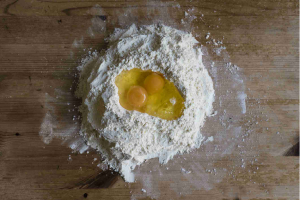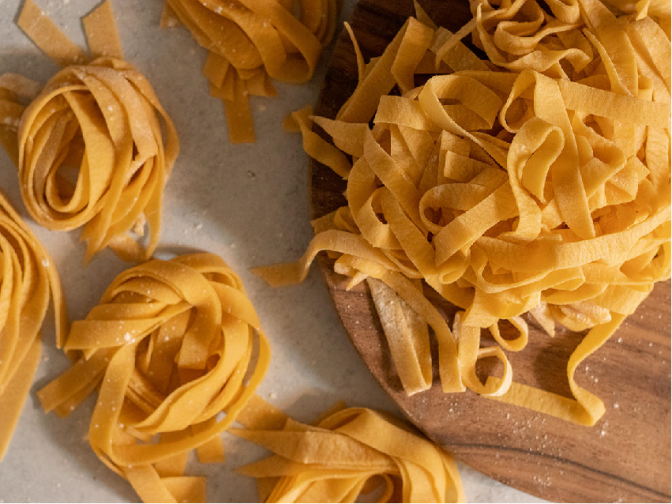An expert like Alberto from Cómeme la pizza, I have prepared this exhaustive article so that you know in depth the flours and the kneading technique to make pasta at home. It is worth reading this article to understand the basics.
We have asked Alberto Gimeno from Comeme la pizza to share the basics of homemade pasta: what you need to know to start making pasta at home, which only requires basic knowledge and a little practice. Take advantage of Alberto’s indications to launch yourself with homemade fresh pasta and stop buying it in supermarkets: you will see how much you appreciate it and what a pleasure to work with it.
Work with flour at home

Once and for all, in this country we have to start losing the fear of making fresh pasta at home. I don’t know why we think fresh pasta is more complicated than making a Ferrán Adriá dish, and it’s not. I think the main reason is simply that as children we have never seen fresh pasta made at home and, to tell the truth, in Spain, we are very little given to working with flour. Fortunately, things are changing.
In my case, I was lucky that my father traveled to Italy when I was little and we always had a pasta machine at home. Every Sunday, my father would prepare a fresh pasta dinner at home with all the ingredients that he had brought from his travels. I think this is the main reason why it has never been difficult for me to get my hands dirty with flour.
What types of flours should I use?
In general, and if you are used to following an Italian cooking blog, it is always recommended to make pizzas and pasta with type 00 flour. The problem is that this flour is not usually easily found in Spain and if we find it in an Italian product store, it is usually more expensive than normal.
In order to be able to make the equivalence to the flours that we have in Spain, we can look at the type of strength that the flour has, which in Spain is reflected by the W of the flour. In general, Italian type 00 flour has a strength of W(90-130) , which in the Spanish case would be pastry flour or normal flour.
Egg pasta
Ingredients to make egg pasta for four people.
400 grams of flour 00
Four “L” eggs
Egg pasta is the easiest pasta to make at home and the one that, in my opinion, gives the best results.
The bad thing about this recipe is that the proportions vary a bit depending on the size of the eggs since these do not usually have an exact measurement and will always change from day to day in size, weight, or proportion of yolk-white.
It is recommended to use the eggs at room temperature, although I know that this is not always possible. In general, we use one egg for every 100 grams of flour.
Hard pasta
Hard pasta is more widespread in the southern areas and some coastal areas of northern Italy. The kneading process is similar to egg pasta, but in this case with water. It is advisable to use seasonal water or warm water so that the hydration of the starch is facilitated.
The preparation is just as simple as the previous one. You simply have to mix the flour and water and knead until we get a homogeneous mixture and the surface is smooth.
Pasta with basil
In addition to these two types of pasta, if we want to vary a bit and play with the recipes so as not to always do the same thing, we can always opt for other types of pasta, such as pasta with spinach, which was already discussed in this blog. , or for example with pasta with basil. I really like this pasta, since basil usually impregnates dishes with a very good smell, and in my house they usually love it.
How do you know if the consistency is ok?
Once we have kneaded the ingredients, it is very important to know the final texture that the dough must have, because if it is very floury, it will be fragile and will break when we work it through the machine, and on the contrary, if it remains with a lot of moisture it will stick when making the spaghetti or the pasta that we want and we will have a misshapen dough when cooked.
To get a homogeneous dough, it is recommended to knead by hand for ten minutes and let it rest for at least half an hour so that later the dough has more elasticity and does not break. To keep the paste, it is better to do it in a transparent film so that the outer layer does not dry out with contact with the air.
The exact point of the dough is just when, after the kneading period, we get the surface of the dough ball to be smooth and homogeneous. By lightly pressing the dough with a finger, it remains a little marked by the pressure, and of course, it does not stick to our hands.
Useful tips to keep in mind
Use the eggs at room temperature and, if possible, break them in a bowl beforehand to make sure that no piece of the shell remains in the flour.
If we use salt, let it be fine salt, so that it is not noticeable in the dough mixture.
Having the surface that we use to knead floured will ensure that the mixture does not stick to the surface and we can work the dough better.
It is recommended to let the dough rest for at least 30 minutes and thus we ensure that the consistency of the dough is better.
You may also be interested in Best Chinese food from Directo al Paladar
